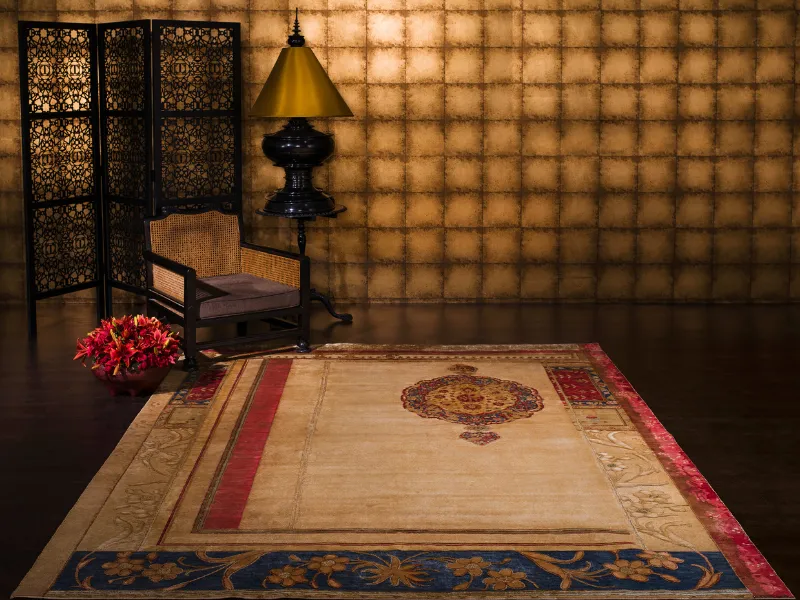Started in Mirzapur in 1920, this homegrown business is now one of India’s leading carpet and rug makers
Started by three British entrepreneurs, Obeetee built its legacy as one of India’s largest handmade carpet and rug makers. Its primary factory in Gopiganj, Uttar Pradesh, has 1,100 employees, and the brand works with 20,000 artisans.
A hundred years ago, on the banks of the Ganges, three British men started a small, carpet-making enterprise. It was 1920, shortly after World War I, and the founders were looking to capitalise on the rising popularity of Indian carpets in the West.
FH Oakley, FH Bowden, and JAL Taylor gathered the finest local craftsmen in Mirzapur, Uttar Pradesh, and began manufacturing carpets. Their business was started as Oakley Bowden & Taylor, and the enterprise derived its brand name Obeetee from the founders’ initials (OBT).
Over the last century, Obeetee built its legacy as one of India’s largest handmade carpet and rug makers. Its primary factory in Gopiganj, Uttar Pradesh, has 1,100 employees, and the brand works with 20,000 artisans who manufacture the handmade products.
In an interview with SMBStory, Gaurav Sharma, MD, Obeetee, says:
“We have strong manufacturing processes and artisans trained in the fine art of carpet weaving. Some of our finest artisans can tie up to 9,000 knots a day. Our hand-knotted qualities range from 15 knots to 300 knots per square inch, which take anywhere between four to 18 months of weaving time.”

Manufacturing of an Obeetee carpet
A rich history of carpet-making
Mirzapur is the heart of rug making in India, and local artisans have built a reputation for excellence in handmade rugs and carpets. By tapping into their skills, Obeetee fuses centuries-old carpet-making skills with modern design techniques to make carpets that come with a choice of more than 4,000 colours.
Gaurav says if someone buys an Obeetee carpet, they are buying a piece of history and participating in a 500-year-old tradition, which dates to the reign of Mughal emperor Akbar, who was particularly fond of carpets.
“Akbar wanted carpets for his palace and tried bringing weavers from Persia to India. However, when they reached Gopiganj, a small town in modern-day Uttar Pradesh, their caravan was attacked by bandits,” Gaurav narrates.
“The surviving weavers took shelter in nearby villages, settled there, and started weaving carpets. This introduced carpet weaving to the area and it became known for the art form. So, when the Obeetee founders wanted to start a business in India, they naturally started it in the nearby town of Mirzapur.”
Business challenges
Obeetee has a diverse product portfolio of rugs and carpets at several price points. The range of flatwoven, tufted, and knotted carpets, dhurries, and floor coverings range from Rs 200 per square feet to Rs 11,000 per square feet.
The Rashtrapati Bhavan in Delhi is home to two Obeetee rugs, the larger of which measures 452 square metres and contains 100 million intricate knots.

A carpet from Obeetee's Proud to be Indian collection
When Gaurav joined the business 25 years ago, he immediately noticed the cyclical nature of the carpet industry.
“Demand can go up and down in this industry. This impacts us as we make handmade products and our weavers are entrepreneurs themselves — not employees. There is a challenge in giving all of them work when demand goes down. If we were selling machine-made products, we could have just adjusted the machines’ capacities and altered our production based on demand,” he says.
Sales model
Over the course of his time at Obeetee, Gaurav saw the brand increasingly sell to large-scale retailers. The US is currently a large market for the company.
“Large retailers work with tight timelines so we can’t sell them handmade products that take months to complete. So, we diversified into hand-tufted carpets that can be made in a few weeks. We also added contemporary and modern designs to cope with the changing demand and tastes of our customers,” he says.
Obeetee is one of the largest overall players in the market for carpets, and competes against smaller, more specialised businesses in individual product categories. Gaurav says this competition is increasing, but is healthy and "inspires the company to push forward across segments".
“To stay ahead of the curve, we recently launched our e-store that offers services in India and abroad. At a time when digital has become a necessity, the e-store will prove to be a blessing in disguise for customers who have put their home furnishing plans on hold due to the pandemic,” he says.

Gaurav Sharma, MD, Obeetee
The way forward
Obeetee is now seeing a lot of traction from customers who couldn’t spend on travel or other recreational activities due to the pandemic, and have instead chosen to enhance their living experience by spending on carpets and rugs.
Other factors boosting the demand for carpets and rugs are urbanisation, rising construction, and a swelling middle class.
“The impact of the pandemic has been largely positive as we work with ecommerce customers who sell to end consumers looking to furnish their homes,” Gaurav says.
“We have seen strong demand during this period and in August 2020, we had the highest production of hand-knotted carpets to meet the demand. Even though some weavers had gone home, we pulled it off.”
Going forward, Gaurav maintains the home furnishings industry will remain strong. He believes the key for Obeetee to continue succeeding in the sector is to become more IT-savvy.
Edited by Saheli Sen Gupta











